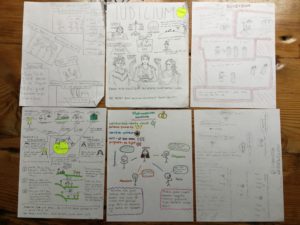
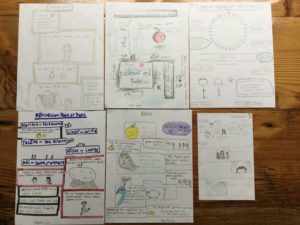
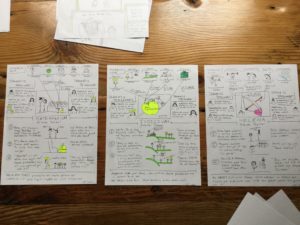
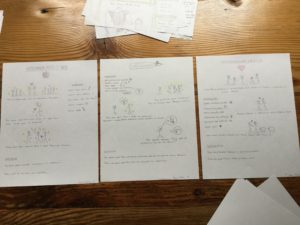
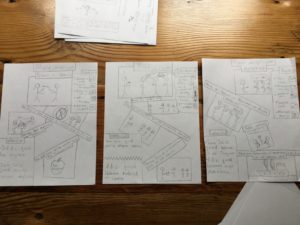
I came across this project while trying to find ways for my students to interact with readings in more creative and self-directed ways, but at the same time hold them accountable for some very specific details, especially when it comes to comprehension of specific words, as well as overall understanding of the story.
A smash doodle drawing is basically a bunch of words and drawings smashed together, kind of like a scrapbook page. A teacher can be as specific or as general as they want in their requirements/instructions, depending on the learning goals. I was very fortunate to come across some very detailed descriptions, including assignment sheets, rubrics, and samples of student work (linked below). I adapted some of those teachers’ instructions for my own class, and on the first day, I showed students a few of those examples.
I decided to try out this project with my second year Latin class, a small, tight, quirky, and very creative group. I knew they could handle something a bit more open-ended–most of them, at least. And for those who couldn’t, The student samples, along with the detailed description of the assignment, and a timeline for turning in work, gave them the support that they needed. This kind of structure and support will allow teachers to do this even with a more difficult class.
Here are the slide show pages which I used to introduce the assignment, and the requirements which I kept up on screen during student work days.
https://docs.google.com/presentation/d/1zcyn6XeLOvdhdcw0v7d8haenQowIRq5zyNk2niATC9w/edit?usp=sharing
Here is the assignment sheet I handed out, again adapted from the excellent resources linked below.
https://docs.google.com/document/d/12iw5P1UojSKzYZecSiUsqxcoq79IupxyljbTBW7WZfA/edit?usp=sharing
I would recommend allowing approximately 1 1/2 to 2 classes per page. Some students will take a bit longer to get requests. And students who want to spend more time on the visuals, as long as they complete the basics, and then take them home and work more. The goal however, is to make sure that students don’t have to spend time outside of class on this. It should not turn into a big homework project. You might also try soending half of the class on these, if you think they can’t handle an entire period. But, as many of our teachers will tell you, 20 minutes is really not enough time even to get started on a creative project like this. Even if you have to start with smaller blocks of time, extending this creative work time during class could be an explicit goal that you and students work toward together.
In order that students take this project seriously, I’ve decided to score each page as worth a quiz (in my gradebook, a quiz is worth half of a test) . And my students completed three of these in the space of about five classes (=1.5 tests in the gradebook). I’m a big fan of telling students up-front something like ” this is worth a quiz,” or “this is worth a test in your gradebook,” especially when it comes to something that is more artistic, open-ended, or even a conversational. I have many students who won’t put all their effort in if there is not this kind of reward/consequence. If you work in a high-performing academic environment, doing this may really help you to transition away from more traditional assessments.
This is not something to do all the time, but is wonderful to have in your rotation, perhaps once or twice a quarter, especially at times when you and your kids need a bit of downtime.
Links:
Elizabeth Dentlinger’s very detailed plan, handout, rubric and more
https://sradentlinger.wordpress.com/2016/03/23/smash-doodles-handout-student-examples-rubric/
Martina Bex’s description, with links
https://martinabex.com/2014/07/10/smash-doodle/
a quick google search (or pinterest!) will give you, and students, thousands of examples of smash doodle drawings and books
